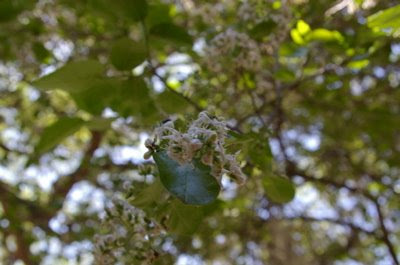I always love visiting the parks and natural areas around Central Texas. They provide a window into what can grow here and show me how things look growing naturally, together. I can stroll through the forest or prairies and see what plants associate with each other, and I find that the best gardens mimic these natural pairings with ease.
This past weekend, I ventured with some (great) friends down to Palmetto State Park near Luling and Gonzales, Texas.
This park is magnificent and a big surprise for those of us used to Ed's Plateau and Blackland Prairie.
The unique geology of the area has resulted in a relatively isolated forest of dwarf palmettos (Sabal minor). And there's a great combination of plants and wildlife there. In fact, we ventured there for the birds - it's on the Texas birding trail and boasts over 200 species in a very small area.
But the swampy flats, palmettos and Spanish moss swaying from the trees reminds me of coastal Carolina.
Red buckeyes (Aesculus pavia) were in full bloom, hanging out in the understory. Hummingbirds like these and in fact, we came across one (my first for the season) nectaring on a buckeye.
The River Trail is characterized by anacua (Ehretia anacua) or sandpaper tree. This was a very nice surprise for me, since I just planted one of these trees in my front yard. This is the very northern tip of its range. Many of the anacua were in full bloom, filled with white flowers. I couldn't quite catch their scent, but I think that may be because it was cold and windy this past weekend.
Along the Palmetto Trail, yellow irises were blooming. The yellow iris is introduced from Eurasia and Africa, but it's purty.
Apparently, the native purple iris also lives in the park, but it was not in bloom while we were there. It'd be a pretty sight to see the yellow and purple blooming together in a big stand.
One of the things I find the most fascinating about Austin is that we live on this strange convergence of ecosystems. The Blackland prairie and Edward's Plateau meet along the relatively defined line of the Balcones Fault. But just a stones throw away, you can find a swampy palmetto forest, or the Lost Pines. Tropical species reach their northern limits here and the Post Oak Savannah is not too far away.
Nice place. I definitely recommend a visit.
***
I haven't been blogging much about the yard, which is just crazy, because there are so many things in bloom right now. A perfect time of year. I hope to get to that soon. Lots to document.










3 comments:
Central Texas is indeed an oddity because we're right where North America and South America joined which is something I found out recently. It explains the diversity in the land and how much limestone we have! lol.
I'm definitely going to have to visit Palmetto State Park now.
Just thought I would say Hi ,I love yor garden , I am orginally from austin , now based in IA (We cant plant here yet because it still way to cold). My family is moving to austin in august , so i wanted to take a glimpse at what I will have to look froward to again. Thank you so much for having such a wonderful blog. I can't wait to return home again. I sometimes forget just how beautiful it was.
Nice pics and description of the park.
Post a Comment